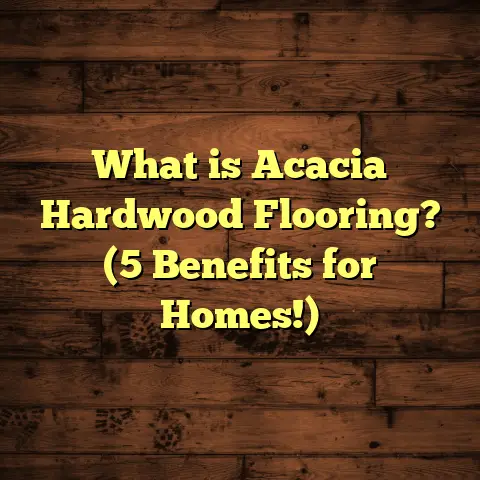What is DK Sq Feet on a Floor Plan? (5 Key Insights Explained)
I remember the first time I opened a floor plan and saw the term “DK Sq Feet” scribbled in a corner. I scratched my head, wondering what exactly that meant. If you’ve ever found yourself staring at a blueprint or floor plan thinking, “What on earth is DK Sq Feet?”—you’re not alone. It’s one of those terms that can trip up homeowners, contractors, and even some designers.
So, let me walk you through what DK Sq Feet means, why it matters, and how I’ve used this info to make smarter decisions on flooring projects. Along the way, I’ll share some stories and insights from my own experience that might help you avoid common pitfalls.
What is DK Sq Feet on a Floor Plan?
Simply put, DK Sq Feet usually stands for Dining Kitchen Square Feet. It’s a way to indicate the size of the combined dining and kitchen area in square feet on a floor plan. This measurement helps you understand how much space is allocated for cooking and eating in an open-concept or connected layout.
You might see it written as “DK 200 sq ft,” meaning the dining-kitchen area covers 200 square feet. This is useful because it gives a clear picture of usable space in one of the most important rooms in a home.
Why Does DK Sq Feet Matter?
Knowing the exact square footage of your dining and kitchen space is super helpful when planning flooring. Different flooring materials behave differently depending on the room’s use and size. For example, a kitchen-dining combo will have more foot traffic, spills, and wear compared to a bedroom. So, understanding DK Sq Feet helps you:
- Estimate flooring material needs accurately
- Budget for installation and materials
- Choose the right flooring type for durability and style
- Plan for maintenance based on room size and use
I learned this firsthand when I worked on a renovation project where the DK space was underestimated by about 50 sq ft. The client ran out of flooring material halfway through installation — a costly oversight that delayed the project by days.
How DK Sq Feet is Calculated
Floor plans usually provide dimensions for each room or area, like length and width in feet. To get the DK Sq Feet: DK Sq Feet=Length (ft)×Width (ft)\text{DK Sq Feet} = \text{Length (ft)} \times \text{Width (ft)}
If the space isn’t a perfect rectangle, they might break it down into sections and add them up or use software that calculates irregular shapes.
For instance, if your dining kitchen area measures 15 feet by 14 feet: 15×14=210 sq ft15 \times 14 = 210 \text{ sq ft}
That’s your DK area on the floor plan.
Handling Irregular Shapes
Not all kitchens and dining areas are simple rectangles or squares. Some homes have L-shaped kitchens or spaces that curve around walls or cabinetry. In these cases, calculating DK Sq Feet becomes trickier.
Here’s how I handle it:
- Break down the space into smaller rectangles or squares.
- Calculate each section’s area separately.
- Add all the areas together to find total DK Sq Feet.
For example, imagine an L-shaped kitchen-dining area with two rectangles:
- Main kitchen: 12 ft by 10 ft = 120 sq ft
- Dining nook: 8 ft by 7 ft = 56 sq ft
Total DK Sq Feet = 120 + 56 = 176 sq ft
This method gives you a more realistic measurement than guessing or rounding off.
How I Use DK Sq Feet in Flooring Projects
When I start a flooring job, getting accurate measurements upfront saves headaches later. Here’s how I approach it:
1. Material Estimation & Waste Factor
Knowing DK Sq Feet helps me order just the right amount of flooring. I always add about 5-10% extra material for waste — that covers cutting mistakes, irregular room shapes, and future repairs.
For example, if the DK area is 210 sq ft, I’ll order around: 210×1.1=231 sq ft210 \times 1.1 = 231 \text{ sq ft}
This buffer is crucial because kitchens see a lot of wear, and you might want to replace damaged boards down the line without hunting for matching material.
One time, working on a client’s open-concept kitchen-dining room, we faced an unexpected challenge: the wall wasn’t exactly square. Because we ordered with an appropriate waste factor, we had enough material to handle tricky cuts around angled walls without causing delays or extra costs.
2. Flooring Type Selection
The type of flooring you pick for your DK space depends heavily on how that area will be used.
- Vinyl or luxury vinyl planks (LVP): These are waterproof and great if you expect spills.
- Engineered hardwood: Looks beautiful but can be pricey and less water-resistant.
- Porcelain tile: Durable but cold underfoot unless you have radiant heating.
- Laminate: Often more affordable with decent durability but less water-resistant than vinyl.
- Cork: Comfortable and eco-friendly but can be damaged by water exposure.
Your DK Sq Feet helps decide how much material you need of each type—and what installation method makes sense. For example, larger areas might benefit from floating floors for easier expansion and contraction.
Personal Insight: Choosing Flooring Based on Use
I once advised a client who loved real hardwood but had a kitchen prone to spills from her three kids and pets. The DK area was about 250 sq ft. We settled on high-quality waterproof vinyl planks with a wood-look finish instead of hardwood.
Why? Because maintaining hardwood in such a high-moisture zone would’ve been a nightmare. The client was happy with the look and durability—and stayed within budget since vinyl tends to cost less per square foot.
3. Installation Planning
The size of your DK space determines installation time and labor costs. Larger spaces take longer to prep and finish.
I’ve tracked my projects over the years, and here’s what I’ve found:
| DK Size (sq ft) | Average Installation Time (hours) | Approximate Labor Cost* |
|---|---|---|
| Up to 150 | 6 | $500 |
| 150 – 300 | 10 | $850 |
| Over 300 | 15+ | $1,200+ |
*Labor cost varies by region but these are typical figures based on my experience in mid-size cities.
Also important: Subfloor condition impacts installation time heavily. Uneven subfloors require extra prep like leveling compounds or replacing boards before laying new flooring.
In one project where the DK Sq Feet was about 180 sq ft, uneven plywood subflooring added two days to installation—but knowing the exact square footage upfront helped us budget that time properly without surprises.
What You Should Know About Maintenance for DK Flooring Areas
Since the dining kitchen area often sees heavy foot traffic, moisture exposure, and food spills, choosing and maintaining the right flooring is key.
Cleaning Tips Based on Flooring Type
- Vinyl/LVP: Wipe spills immediately with mild soap and water. Avoid harsh chemicals.
- Hardwood: Sweep regularly; clean with products designed for wood floors. Avoid standing water.
- Tile: Mop with neutral cleaners; grout may need periodic sealing to prevent stains.
- Laminate: Clean with laminate-specific cleaners; avoid water pooling.
- Cork: Use gentle cleaners; reseal periodically to maintain water resistance.
In my experience working with homeowners, those who pay attention to cleaning routines extend their flooring lifespan by several years. One client told me their vinyl floor lasted over 20 years because they consistently wiped up spills right away.
Repair Considerations
With DK areas being high-traffic, small damages are common. Knowing your DK Sq Feet helps estimate how much replacement material you should keep handy for quick fixes.
For example, if your total DK area is large (300+ sq ft), it’s smart to store about 5% extra planks or tiles for repairs.
In one case, a family accidentally dropped a heavy pan that cracked several porcelain tiles in their kitchen-dining area (about 320 sq ft). Fortunately, they had leftover tiles from initial installation due to proper waste planning based on their DK Sq Feet. They replaced tiles quickly without having to reorder—and pay for—new batches which would have delayed repair by weeks.
Deeper Look: Impact of DK Sq Feet on Flooring Cost Estimates
Cost estimation is one of the most practical reasons to understand DK Sq Feet clearly.
Let me break down cost factors based on my experience:
| Flooring Type | Material Cost per Sq Ft | Installation Cost per Sq Ft | Total Cost per Sq Ft |
|---|---|---|---|
| Vinyl / LVP | $2 – $5 | $1 – $3 | $3 – $8 |
| Engineered Hardwood | $4 – $10 | $3 – $6 | $7 – $16 |
| Solid Hardwood | $5 – $12 | $4 – $7 | $9 – $19 |
| Porcelain Tile | $3 – $10 | $5 – $10 | $8 – $20 |
| Laminate | $1.5 – $4 | $1 – $3 | $2.5 – $7 |
Let’s say you have a DK space of 250 sq ft:
- Vinyl flooring total cost: 250×$5=$1250250 \times \$5 = \$1250 (mid-range)
- Hardwood total cost: 250×$12=$3000250 \times \$12 = \$3000 (top end)
These are rough numbers but illustrate how your DK Sq Feet directly impacts your budget.
Case Study: Budgeting Based on Accurate DK Measurements
A couple I worked with underestimated their dining-kitchen area by about 40 sq ft initially—thinking it was only 210 sq ft instead of closer to 250 sq ft due to an alcove not included in their rough measurement.
They had budgeted vinyl flooring at around $1,000 but ended up needing $250 more just for materials plus extra labor costs due to last-minute changes.
Lesson learned: Precise DK Sq Feet measurements save money long-term by preventing surprises after purchase.
Unique Challenges When Working with Open Concept Kitchens & Dining Areas
Open-concept layouts blur boundaries between rooms but make measuring DK Sq Feet both more important and more challenging.
Why?
Because these spaces often flow into living rooms or hallways without walls defining them clearly.
In these situations:
- You might need to decide where dining-kitchen ends and living room begins for flooring purposes.
- Some clients want different flooring types in each zone; others prefer continuous flow.
When clients want different flooring types in open spaces (say tile in kitchen, hardwood in dining), accurate zoning measurements become crucial for ordering material and planning transitions like thresholds or trim pieces.
My Experience With Open Concepts
I once worked on a modern loft where the entire first floor was mostly open plan—kitchen merged seamlessly into dining and living spaces totaling about 900 sq ft combined.
Client wanted tile in kitchen and hardwood elsewhere.
Using laser measuring tools allowed me to define precise boundaries for each flooring type without guesswork—critical since tile requires different subfloor prep compared to hardwood.
We ended up with:
- Kitchen tile area (DK): ~350 sq ft
- Dining hardwood area: ~200 sq ft
- Living hardwood area: ~350 sq ft
Clear measurements avoided ordering errors and ensured smooth installation transitions.
How Technology Helps Calculate & Use DK Sq Feet More Accurately
Gone are the days when contractors had to rely solely on manual tape measurements and rough sketches.
Now there are tools like FloorTally (which I use often) that help streamline cost estimation and material calculation based on floor plans including DK areas.
What FloorTally Offers Me:
- Local pricing integration for materials & labor
- Waste factor adjustments automatically calculated
- Visual layout options to confirm areas before ordering
- Quick generation of detailed quotes based on precise square footage like DK Sq Ft
Using such tools has saved me hours per project while improving accuracy significantly.
Tips for Homeowners: What You Can Do About Your DK Square Footage Before Starting Flooring Work
If you’re planning flooring work yourself or managing contractors, here are some practical tips:
- Measure Twice, Order Once
Use a tape measure or laser distance meter to get exact length & width of your dining-kitchen space before ordering materials. - Account for Irregular Spaces
Don’t guess—break down irregular shapes into smaller parts then add up areas for total DK sqft. - Add Waste Factor
Order at least 5-10% extra material to cover cuts & future repairs—especially important for kitchens prone to spills & wear. - Discuss Flooring Type Early
Talk with your contractor about which materials suit your lifestyle best given use patterns in your DK area. - Clarify Zones in Open Concepts
If your floor plan has open areas without walls, define where kitchen/dining ends so everyone agrees on measurements & material needs.
FAQs About DK Sq Feet on Floor Plans
Q: Can DK Sq Feet include pantry or breakfast nook?
A: Usually yes—if those areas are open or directly connected to kitchen/dining space, they’re counted as part of total DK square footage.
Q: How much waste factor should I order?
A: Typically between 5%-10%, but higher if room shape is irregular or if installing patterned floors requiring precise cuts.
Q: Is DK Sq Feet always labeled clearly on floor plans?
A: Not always—sometimes you’ll have to calculate it yourself based on room dimensions provided or ask your architect/designer for specifics.
Final Thoughts About Understanding “DK Sq Feet”
Knowing exactly what “DK Sq Feet” means on your floor plan isn’t just trivia—it can save time,
money,
and stress when selecting flooring materials,
planning installation,
and maintaining your floors over time.
From my years working hands-on,
I’ve seen how precise measurement upfront makes projects smoother,
budgets tighter,
and outcomes better looking for clients every single time.
If you’re faced with mysterious abbreviations like “DK,” stop guessing—
get out your tape measure,
consult your contractor,
or use tech tools like FloorTally to get clear number-driven answers before ordering materials or scheduling installers.
Have you ever been caught off guard by unexpected floor plan details? What did you learn? I’m always interested in hearing stories from fellow homeowners and pros alike!
If you want me to help interpret your floor plan or guide your next flooring project based on your specific DK square footage,
just ask!
I’m here to help make your floor project less confusing and more rewarding every step of the way.





